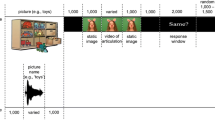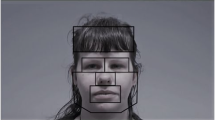Abstract
Individuals with Asperger syndrome (AS) have problems in following conversation, especially in the situations where several people are talking. This might result from impairments in audiovisual speech perception, especially from difficulties in focusing attention to speech-relevant visual information and ignoring distracting information. We studied the effect of visual spatial attention on the audiovisual speech perception of adult individuals with AS and matched control participants. Two faces were presented side by side, one uttering /aka/ and the other /ata/, while an auditory stimulus of /apa/ was played. The participants fixated on a central cross and directed their attention to the face that an arrow pointed to, reporting which consonant they heard. We hypothesized that the adults with AS would be more distracted by a competing talking face than the controls. Instead, they were able to covertly attend to the talking face, and they were as distracted by a competing face as the controls. Independently of the attentional effect, there was a qualitative difference in audiovisual speech perception: when the visual articulation was /aka/, the control participants heard /aka/ almost exclusively, while the participants with AS heard frequently /ata/. This finding may relate to difficulties in face-to-face communication in AS.



Similar content being viewed by others
Notes
As in that study, it should be noted that the Asperger group was not homogenous. Some AS participants heard the ApVk stimulus as K in the same way as the control participants, while other AS participants heard more T. These individual differences are described in more detail in Saalasti et al. (2011).
References
Allen G, Courchesne E (2001) Attention function and dysfunction in autism. Front Biosci 6:105–119
Alsius A, Navarra J, Campbell R, Soto-Faraco S (2005) Audiovisual integration of speech falters under high attention demands. Curr Biol 15(9):839–843
American Psychiatric Association (1994) Diagnostic and statistical manual of mental disorders DSM-IV, 4th edn. American Psychiatric Association (APA), Washington DC
Ames C, Fletcher-Watson S (2010) A review of methods in the study of attention in autism. Dev Rev 30:52–73
Andersen TS, Tiippana K, Laarni J, Kojo I, Sams M (2009) The role of visual spatial attention in audiovisual speech perception. Speech Comm 51:184–193
Belmonte M (2000) Abnormal attention in autism shown by steady-state visual evoked potentials. Autism 4(3):269–285
Belmonte MK, Yurgelun-Todd DA (2003) Functional anatomy of impaired selective attention and compensatory processing in autism. Cogn Brain Res 17(3):651–664
Bird G, Catmur C, Silani G, Frith C, Frith U (2006) Attention does not modulate neural responses to social stimuli in autism spectrum disorders. NeuroImage 31(4):1614–1624
Burack JA (1994) Selective attention deficits in persons with autism: preliminary evidence of an inefficient attentional lens. J Abnorm Psychol 103:535–543
De Gelder B, Vroomen J, van der Heide L (1991) Face recognition and lip-reading in autism. Eur J Cogn Psychol 3:69–86
Ehlers S, Gillberg C, Wing L (1999) A screening questionnaire for Asperger syndrome and other high-functioning autism spectrum disorders in school age children. J Autism Dev Disord 29(2):129–141
Frith U (1992) Autism and Asperger syndrome. Cambridge University Press, Cambridge
Frith U (2004) Emanuel Miller lecture: confusions and controversies about Asperger syndrome. J Child Psychol Psychiatry 45:672–686
Goldstein G, Johnson CR, Minshew NJ (2001) Attentional processes in autism. J Autism Dev Disord 31(4):433–440
Iarocci G, McDonald J (2006) Sensory integration and the perceptual experience of persons with autism. J Autism Dev Disord 36(1):77–90
Iarocci G, Rombough A, Yager J, Weeks DJ, Chua R (2010) Visual influences on speech perception in children with autism. Autism 14(4):305–320
Keane BP, Rosenthal O, Chun N, Shams L (2010) Audiovisual integration in high functioning adults with autism. Res Autism Spectr Disord 4:276–289
Klin A, Volkmar FR, Sparrow SS (2000) Diagnostic issues in Asperger syndrome. In: Klin A, Volkmar FR, Sparrow SS (eds) Asperger syndrome. The Guilford Press, New York, pp 25–71
Lord C, Rutter M, Le Couteur A (1994) Autism diagnostic interview-revised: a revised version of a diagnostic interview for caregivers of individuals with possible pervasive developmental disorders. J Autism Dev Disord 24:659–685
Lord C, Risi S, Lambrecht L, Cook EH Jr, Leventhal BL, DiLavore PC, Pickles A, Rutter M (2000) The autism diagnostic observation schedule-generic: a standard measure of social and communication deficits associated with the spectrum of autism. J Autism Dev Disord 30:205–223
Massaro DW (1987) Speech perception by ear and eye: a paradigm for psychological inquiry. Lawrence Erlbaum Associates, Hillsdale
Massaro DW, Bosseler A (2003) Perceiving speech by ear and eye: multimodal integration by children with autism. J Dev Learn Disord 7:111–144
McGurk H, MacDonald JW (1976) Hearing lips and seeing voices. Nature 264:746–748
Mongillo EA, Irwin J, Whalen DH, Klaiman C, Carter AS, Schultz RT (2008) Audiovisual processing in children with and without autism spectrum disorders. J Autism Dev Disord 38(7):1349–1358
Posner MI, Snyder CR, Davidson BJ (1980) Attention and the detection of signals. J Exp Psychol 109(2):160–174
Remington A, Swettenham J, Campbell R, Coleman M (2009) Selective attention and perceptual load in autism spectrum disorder. Psych Sci 20:1388
Soto-Faraco S, Navarra J, Alsius A (2004) Assessing automaticity in audiovisual speech integration: evidence from the speeded classification task. Cognition 92(3):B13–B23
Tiippana K, Andersen TS, Sams M (2004) Visual attention modulates audiovisual speech perception. Eur J Cogn Psychol 16(3):457–472
Tuomainen J, Andersen TS, Tiippana K, Sams M (2005) Audio-visual speech perception is special. Cognition 96(1):B13–B22
Williams JHG, Massaro DW, Peel NJ, Bosseler A, Suddendorf T (2004) Visual–auditory integration during speech imitation in autism. Res Dev Disabil 25:559–575
World Health Organization (1992) International classification of diseases, 10th Revision (ICD-10). WHO, Genova
Acknowledgments
We are grateful to the participants of this study. We thank B.Sci Tapani Suihkonen for participating in the preparation of the experiment, MD Ph.D. Taina Nieminen-von Wendt for help with diagnostic expertise, professor Pirkko Oittinen for providing access to the eye tracking equipment and M.Sci Mari Laine-Hernandez for help with the equipment. PhD Minna Laakso and PhD Eira Jansson-Verkasalo gave useful comments as the supervisors of Satu Saalasti’s PhD thesis. This study was funded by Langnet, the Finnish Graduate School of Language Studies and the Jenny and Antti Wihuri foundation. We dedicate this study to the memory of professor Lennart von Wendt.
Author information
Authors and Affiliations
Corresponding author
Additional information
An erratum to this article can be found at http://dx.doi.org/10.1007/s00221-012-3029-4.
Rights and permissions
About this article
Cite this article
Saalasti, S., Tiippana, K., Kätsyri, J. et al. The effect of visual spatial attention on audiovisual speech perception in adults with Asperger syndrome. Exp Brain Res 213, 283–290 (2011). https://doi.org/10.1007/s00221-011-2751-7
Received:
Accepted:
Published:
Issue Date:
DOI: https://doi.org/10.1007/s00221-011-2751-7




